This is a stage specific preview that touches on the history of each. It is a spoiler-free preview, only including stages released on the Dojo blog prior to January 31, 2008.
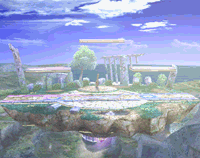
Battlefield
The venerable Battlefield returns for its second run on the Smash Bros. stage list. Battlefield is a no-frills stage that doesn't get in the way of the brawling action. It originally appeared in the N64 version's single player mode. You might make the argument that it's the centerpiece Super Smash Bros. stage, as it was the one chosen to be the first seen in the game's debut trailer at E3 2006. (Snake was scoping out the competition from his cardboard box on the Battlefield too, don't forget.)
Just as it was in Melee, Battlefield will have a flat, level ground surface with three floating pass-through platforms, two on the sides and a higher one above them in the middle. To change things up a little, the time of day will change from game to game, so you might be fighting at noontime during one game and under the cover of darkness during another. Either way, there are no traps, hazards, or gimmicks on this stage. It's just you versus your opponents. Of course, that also leaves you with no excuses if you lose, so you'd better make sure you've got the skills to hold your own on it.

Battleship Halberd
Meta Knight's masked battleship, the Halberd, made its first appearance in Kirby Super Star. A hulking warship driven by two giant batwings, Meta Knight planned to use his powerful vessel to conquer Dreamland. Manned by a crew of Waddle-Dee sailors, the Halberd was only stopped due to Kirby's intervention. The ship was destroyed when Kirby defeated Meta Knight on its deck and then destroyed the ship's reactor.
The Halberd resembles a combination of a few types of stages from Super Smash Bros. Melee. The stage starts in the Halberd's hangar, and as such is a simple flat stage. At this time the bow of the Halberd looms over the action. When the Halberd takes off, the platform on which the battle had been taking place follows along with it leaving a two tiered stage. Finally, as the platforms pass over the bridge the combatants are forced to be wary of the Halberd's cannons, which could open fire at any moment or could use their attached arm to interfere in the proceedings.
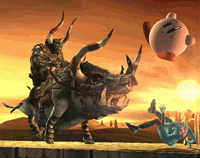
Bridge of Eldin
While the Zelda universe was well represented in both of the previous Smash games, one of the unique areas from Twilight Princess is being showcased in Brawl. The Bridge of Eldin is the location of one of the most memorable moments of the Zelda epic, the famous joust between Link and King Bulbin. After that battle the bridge crumbled, making it impassable until Midna brought the center section back from the desert. Those two concepts are brought into the stage in Brawl.
The battle takes place on the long stone bridge. Unlike most Smash Bros. levels there are no other platforms to jump on, which should make for fairly straightforward battles - that is, until the bridge crumbles completely. Once that happens, the battle continues for a little while, until the missing chunk is brought back in by Midna. On top of that, King Bulbin himself will make an appearance from time to time, knocking any potential victims off of the bridge entirely.
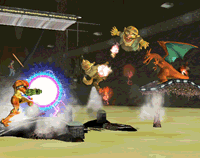
Brinstar
Brinstar returns! The iconic subterranean series of caverns and chambers that Samus first explored in the original Metroid game makes another appearance in Smash Bros., placing combatants high above a subterranean acid lake.
They'll need to be careful, as Brinstar's platforms break apart and tilt when their tendon-like connections are destroyed. But the real hazard in Brinstar is the acid, which periodically surges to such heights that only the uppermost center platform is left to stand on until the acid subsides.

Castle Siege
Castle Siege is a new Brawl stage to represent the entire Fire Emblem saga, and as such doesn't refer to any one game in particular. Instead it cycles through three completely unique fighting environments. It's like three stages in one!
The first environment is on top of the walls of a castle, with off-screen catapults launching fireballs in the background, foreground, and occasionally at you. Then a momentary transition places you inside the castle, in a throne room with stone statues holding up destructible platforms. After another transition you'll find yourself on a gently swaying rock platform inside a volcano! After that you're back on the castle walls! Epic!
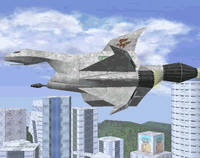
Corneria
This faithful reproduction of the Super Smash Bros. Melee stage has players fighting on the spine of the (not-to-scale) Great Fox, Fox McCloud's mother ship from the Star Fox games, as it gently cruises through the landscapes of the planet Corneria.
This stage notably lacks platforms (aside from the occasional Arwing flyby), but it features a grotto-like area behind the Great Fox's "dorsal fin" and a giant laser cannon underneath the cockpit that especially courageous players can stand on. Look out for Arwing strafing runs!
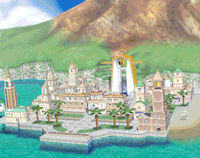
Delfino Plaza
Take a flight through the skies of Isle Delfino and duke it out in different parts of the plaza in this stage based off of the hub town of the GameCube's Super Mario Sunshine. The battle locations alternate around town, with locations ranging from a flat pathway on the mainland to a small island out at sea. One location contains a pit which will KO you should you get knocked down into it. The entire island town seems to be ripped straight out of Mario's GameCube adventure, so those that played through it should feel right at home.
That is, until you get whisked away to another area. A floating platform will rise up out of the ground and take the fight high into the air, careening towards its next stop in town. Because there is no ground other than the relative safety of the main platform, you can get knocked out from all directions. You can also be left behind if you're not quick enough to get on the platform before it takes off.
This stage shares the same mechanic as Mute City in Super Smash Bros. Melee, which also featured an alternating moving platform/static location feature.
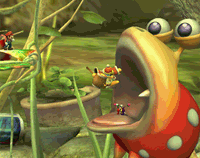
Distant Planet
In the game Pikmin, Captain Olimar was forced to make a crash landing on an uncharted world known only as the "Distant Planet." His spaceship in tatters, he had to rely on the help of the colorful plant-creatures who lend the series their name. Every other creature was a danger that Olimar and the Pikmin had to face, and disaster waited in the grasses if they were not in the safety of their ships by sundown.
The Distant Planet stage is new for Smash Bros. Brawl. The organic stage has vines for a floor that give the stage a distinct bounce. Throwing petals, which fall from flowers, into the Pikmin's onions yield items for the combatants to use. Sporadic downpours can wash the players over the edge, and the giant insects can eat them alive. Nothing is safe when you're smaller than a bug.
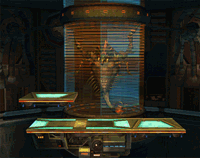
Frigate Orpheon
The doomed Space Pirate frigate Orpheon introduced us all to Retro Studios' three-dimensional vision of Samus Aran's world, Metroid Prime, in a 2002 E3 demo. Such was the impact of this ominous, derelict environment that the initial skepticism surrounding the prospect of playing Metroid through Samus' eyes quickly transformed into feverish anticipation, and the final product fully delivered on that promise.
At the outset of Samus' GameCube debut, the bounty hunter sets out to investigate a distress call from the Orpheon, in orbit around Tallon IV. What she finds is a ruined laboratory complex littered with specimens subjected to Space Pirate experiments. A tense exploration of the dark vessel culminates in a fight with the colossal Parasite Queen, and a good old-fashioned Metroid escape sequence. Samus returns to her gunship just in time as the frigate plunges towards the planet's surface, becoming submerged underwater.
Back in 2001, when Super Smash Bros. Melee debuted, the Metroid Prime series (completed last year with the release of Corruption) didn't exist, so naturally Brawl is the first Smash game to acknowledge Retro's sublime first-person adventures. The Frigate Orpheon stage faithfully recreates Metroid Prime's memorable opening, complete with failing power supply and a menacing Parasite Queen looking on from its containment area. An alert siren warns players that the stage is about to tilt 180 degrees, forcing them into the air and inverting the illuminated terrain.
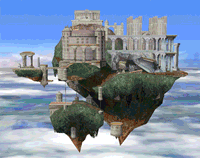
Hyrule Temple
The Smash Bros. Series has always featured Hyrule from the Legend of Zelda series in some form. The original N64 game had Hyrule Castle, and this was followed up by Hyrule Temple in Melee. Hyrule Temple was a huge level where you could chase the characters all around. The reasonably flat platform extended far to the left and right and included a tunnel to a lower section where everyone was sure to get stuck once in a while. This meant that as well as breadth, there were a variety of heights since many of the pillars had platform surfaces for battling on.
The version you see in Brawl is a replica. The level has been remade with minor differences, certain improvements, and new background music.

Lylat Cruise
Welcome to outer space! Combatants on this stage new to Brawl situate themselves on the back of a ship known as the Pleiades, which speeds through Star Fox's Lylat system. The platform itself is no-frills, containing a main deck and three evenly-spaced decks directly above it.
What makes Lylat Cruise so interesting is its highly dynamic background. Team Star Fox engages against team Star Wolf in the middle of an asteroid field. The ship you're fighting on will plunge into the atmosphere, putting the fight in the middle of the upper reaches of one of the system's planets. Eventually, the fight will go back up into space in the middle of an epic battle, complete with giant laser beams and big ships being destroyed.
Of all of the stages that have been revealed thus far, Lylat Cruise looks like it will be the top dog when it comes to visuals. It doesn't look like any of the action in the back will affect the fighting in the foreground, but there's a possibility that the sight of two giant asteroids racing toward the screen and exploding just before they hit the stage could draw your eyes away from the action.
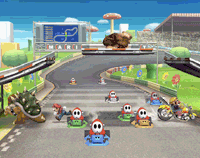
Mario Circuit
Each iteration of the Mario Kart series begins with the simple tarmac Mario Circuit levels. Brawl finally brings the racing competition to the battlefield. The three platforms where battle takes place are fixed above the crossing point of this figure eight circuit. Here you can stand in safety or take a more precarious position standing on the race track.
The main action in this stage comes from the karting Shy Guys, busy making laps around the course. They drive from front to back along the track and leap out at you from the side as they jump over the gap in the figure eight. The map screen at the back shows the location of the Shy Guys, so be aware or be flattened.
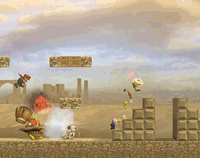
Mushroomy Kingdom
The Mushroom Kingdom is the setting for one of the best selling video game series of all time. The Mushroomy Kingdom is the famous World 1-1 from Super Mario Bros. Easily one of the most recognizable levels in all of gaming, it should get Mario fans reminiscing about the good old days.
The Mushroomy Kingdom is a lot like the Mushroom Kingdom Adventure stage from Super Smash Bros Melee. World 1-1 is faithfully recreated, with the combatants having to manage the jumps and platforming as if they were in Super Mario Bros. The world, now in ruins, scrolls at a "leisurely" pace, which will add a layer of complexity to battles. Players are forced to not only pay attention to each other but the hazards that come with Super Mario Bros. Occasionally the underground World 1-2 will be used instead of World 1-1.
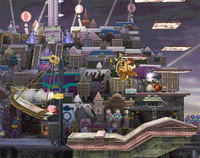
New Pork City
Super Smash Bros. Brawl features characters, items, and stages from Mother 3 even though Nintendo has declared that they won't be translating the game for North American audiences. Mother 3 is the long awaited sequel to the Super NES classic Earthbound, known as Mother 2 in Japan. The original Mother was also never released on North American shores.
New Pork City is the final and most significant location in Mother 3. Anyone who's played Earthbound knows that progressing to new cities and towns is a huge deal, as much of the game's zany plot unfolds in these areas. The city is run by Ness' next door neighbor, Pokey.
The stage version of New Pork City is the largest in Super Smash Bros. history. Rivaling Hyrule Temple for horizontal girth, the level is also much larger vertically than the Zelda level. The level features moving platforms, amusement park rides, and a character called the Ultimate Chimera, who will instantly kill anyone that touches it.
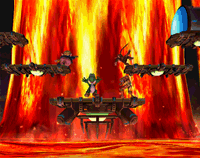
Norfair
The caverns of Norfair, found deep below the surface of Planet Zebes, have been familiarly hostile territory for the Metroid series' bounty hunting heroine. A dimly-lit but boiling-hot environment overflowing with molten rock, Norfair has appeared in the original NES Metroid, its GBA remake Metroid: Zero Mission, and the SNES classic, Super Metroid.
Making its Smash Bros. debut in Brawl, the hellish Norfair recalls previous Metroid-inspired arenas with a rising and falling sea of magma that threatens to engulf combatants at any moment. The danger comes not only from below, but cascades across the stage from the sides and, at times, will inundate the entire playing field as a wall of fiery death pours in from the background. In this situation, the only hope of avoiding a crispy demise is to dive into a protective hatch that forms just as the level is about to be flooded, creating a frantic scramble for position and survival.
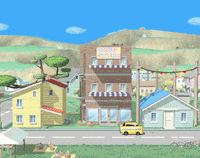
Onett
Onett is the hometown of Ness. This stage is based on Onett, Eagleland from the Earthbound/Mother series. It was the first Earthbound stage in Melee and is included in Brawl.
This is a dangerous stage. While hopping about on the rooftops of Onett stores, you often find yourself falling onto the road as the window shades collapse. This exposes you to traffic zooming past you on the road, and if you are hit you will receive a large amount of damage. Watch out for the black van in particular. You are warned by the honk of a car horn a few seconds in advance, so there's your chance to climb high and escape. Since many of the platforms fall, you and your opponents can easily be knocked into the traffic below.
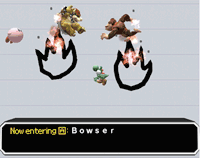
Pictochat
The very same PictoChat application included on the Nintendo DS is a new addition to the series, offering an incredibly dynamic arena with changing features every few seconds. Battling takes place on the same screen you'd see on the top screen of your DS, with the black text box that tells you which room you are currently chatting in as the main base and the scroll bar to the left.
While the screen is rather plain on its own, drawings often appear in a thick black line, hang around for 10-15 seconds, and then disappear before something new is drawn. Examples are pictures that act as platforms or spikes, bombs, and moving platforms that damage you if you come into contact with them.
This stage also allows you to play Mii Channel music and Wii Shop Channel music in the background.
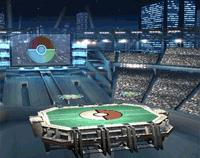
Pokemon Stadium 2
The original Pokemon stadium stage was one of the most dynamic levels in Melee. This new incarnation features the same mechanic, but with completely different transitions. Each of its four different versions is based off of a Pokemon type: Electric, Ground, Flying, and Ice. Players will have to adapt each time the stage changes, as these are much more than cosmetic differences. For example, the ice version is extremely slippery and the wind version allows players to jump extremely high!
The concept for the stage comes out of the stadiums present in the original Pokemon Stadium games for the N64. While those were the first visual representations of battle arenas of this size in a video game, the concept goes all the way back to the original Pokemon games for the Game Boy, in which Pokemon League matches presumably took place in front of thousands of spectators. Those spectators can be seen in the background of the brawl stage.
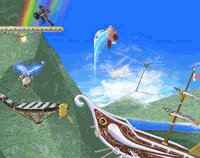
Rainbow Ride
Rainbow Ride was originally a course in Super Mario 64. Hop on the magic carpet and you would be taken on a journey, crossing the rainbow to the airship where you could find a star at the top.
Brawl has a copy of the level known as Rainbow Cruise in Melee. The action scrolls around the stage with a limited area in view and has you jumping across platforms, onto the ship, and off of the ship again. There are a lot of small platforms, some that disappear after a while, some that drop down after you land on them, and magic carpets that move you around. You'll be fighting for space as well as KOs. The ship itself swings back and forth in the center of the stage, but it also takes you on a tour around the level, threatening to throw you off the ship entirely!
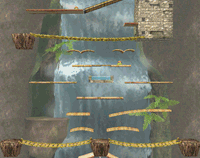
Rumble Falls
Based on the DK Bongo controller-powered Donkey Kong: Jungle Beat, which was in turn styled after the Donkey Kong Country games, this level is full of trees, vines, and logs. The original game is fast-paced, with the player constantly moving on the ground, in the air, or under water in pursuit of bananas.
The screen is constantly scrolling upwards, so you'll have to keep moving in order not to get trapped below. Climb up ladders, jump up the platforms and barrels...anything that leaves your opponents behind! As you go up, the waterfall goes down, down, down. Don't think that you've reached the end when the water stops though; you still have some way to go to reach the top.
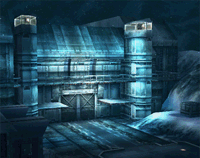
Shadow Moses Island
Shadow Moses Island is the Jerusalem of the Metal Gear Solid mythos. A nuclear testing facility off the Alaska coast, the island is the setting of the first Metal Gear Solid game which was available on Playstation and later remade on GameCube. Solid Snake had to sneak into the facility after it was taken over by Foxhound, a group of terrorists made up entirely of Snake's former black ops unit. The repercussions of the events on that island have been felt in every Metal Gear Solid game since.
This stage, like Solid Snake himself, premieres in Super Smash Bros. Brawl. The level is comprised of the hangar doors to the Shadow Moses facility in front of the heli-pad. This is the first area Snake must navigate after crawling out of the freezing Alaska water. The level has two columns on either side that can be destroyed by character attacks. Until they're destroyed, the columns prevent sideways KOs.
The level itself has features from a variety of Metal Gear games. Occasionally a Metal Gear will break the back wall and peek its head in. While Metal Gear Rex from the original MGS will show up from time to time, so will Metal Gear Ray from MGS2, and the new GEKKO model found in Metal Gear Solid 4. The music in the stage is from many different Metal Gear games, including MGS3 and 4.
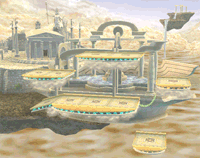
Skyworld
Pit is making his first ever Smash Bros. appearance, so the Kid Icarus universe needed at least one stage to go along with him. That stage is Skyworld. As the name implies, the stage looks like a Greek temple in the sky, with columns and buildings looking similar to the platforming stages of the original NES title Kid Icarus.
During a battle any of the platforms may be destroyed by the force of a player or item. After being destroyed they will quickly regenerate, meaning their use is in constant flux. It seems as if the stage was designed to cause a lot of unexpected falls and possible self-destructions. This fits well with the gameplay of the original Kid Icarus game, as incidental falling was one of the most common (and most frustrating) forms of death in that game.
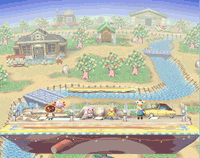
Smashville
A rather unoriginal name, don't you think? Smashville is Brawl's Animal Crossing-styled level, a game in which your town is named whatever you wish. Animal Crossing first appeared on the Nintendo 64 in Japan, saw a worldwide release on GameCube, and then delivered a slightly upgraded sequel on the Nintendo DS.
The day/night system of the game is represented depending on the time of the Wii internal clock. The scenery and lighting changes to match the current time. The battling takes place on a platform floating above the town, with many of the town's most memorable characters present to witness the action. Even the museum basement cafe is open for refreshments. And you know what that means: a live music performance from the talented K.K. Slider every Saturday at 8pm!
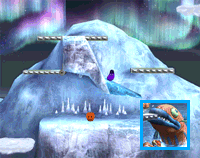
The Summit
The Ice Climbers are making a return to the Smash scene in Brawl. Does that mean the much-maligned Icicle Mountain stage will be returning as well? While we don't know the answer to that, we do know that it won't be their primary stage. Brawl will feature The Summit which is based on the bonus portion of an original Ice Climber level. In that classic game, when Nana and/or Popo get to around the 3/4 mark of a level, the music changes, there are no more enemies, and a timer appears. They then have to race to the top as fast as possible, collecting random vegetables along the way for bonus points.
At first glance, the Brawl stage looks like a standard level, with platforms at various heights to jump on and off of. That isn't the case though, as at some point in the fight the peak will break off and begin sliding down the side of the mountain. While on its way down, it will be a challenge for players to stay on it and not get left behind. At the end of it's descent it splashes into the sea and starts floating. While floating, the famous Polar Bear appears and pushes the giant ice cap into the water, removing some play area from the fight. The water is also patrolled by a giant orange fish, which isn't from any Ice Climber games, but rather appears courtesy of its sister game Balloon Fight.
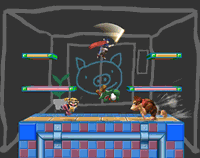
WarioWare
The WarioWare series is built on chaotic "microgames" that require a quick reaction to an onscreen command. All WarioWare games have included the ability to play random microgames in rapid succession. WarioWare, Inc. Mega Microgame$ represented each of these random microgames as a floor in a skyscraper. It is this perilous elevator ride that made its way into Brawl.
The WarioWare series and its stage are making their Smash Bros. debut in Brawl. There is nothing in the Smash Bros. series that is anything like WarioWare. The stage is constantly changing, offering up microgames taken from the WarioWare series. Objectives like "dodge [the arrows]" and "jump" will appear frequently and each microgame will present a different hazard. Between each microgame is a platform level, where the combatants fight while waiting for the elevator to reach their next task. Follow each microgame's directions to survive and receive a reward. Fail and it could be disaster!
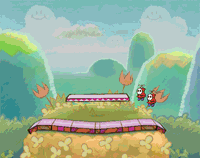
Yoshi's Island
Not to be confused with the Melee stage of the same name based off of Super Mario World, the new Yoshi's Island takes on a more basic appearance compared to the original Super Smash Bros. stage. The Brawl version has a gentle dip in the center of the main platform and a single platform above it that, according to the Smash Bros. Dojo update, "tilts to and fro." Instead of remaining static or sliding to the left and right as it appears it would, it looks like it will instead rock back and forth, or possibly spin depending on how much weight is applied on either side of it.
A Support Ghost will occasionally appear off the edges of the main platform, raising an additional platform that extends the play field. These platforms could save you if you get knocked a great distance away from the main platform. Flying Shy Guys (Fly Guys, if you will) also appear on occasion, toting helpful items. Yoshi's Island changes its appearance from time to time, much like Battlefield. However, unlike the day-night cycle in that stage, Yoshi's stage cycles through the four seasons of the year. The changes are merely cosmetic, though, so you don't need to worry about slipping around if it's winter.
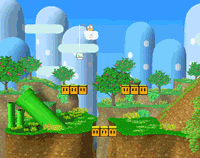
Yoshi's Island (Melee)
Making its return from Melee, Yoshi's Island once again brings the landscape of Super Mario World's early levels to life as a compact battleground in Brawl. The yellow blocks, tall blue hills, slanting pipes, and steep slopes of Yoshi's home (as depicted in the SNES launch day classic) are all represented in this tightly constructed stage, and you may even spot Lakitu hovering atop a cloud.
The confined play area of this stage can make for some very short-lived battles, and with little airspace surrounding the ground, this can favor heavyweight characters. The yellow blocks in the center of the stage can easily be flipped to uncover a potentially deadly chasm, so be careful not to let a mallet become the instrument of your own demise!
Evan Burchfield, James Jones, Greg Leahy, Carmine Red, Steven Rodriguez, and Karlie Yeung also contributed to this article.
